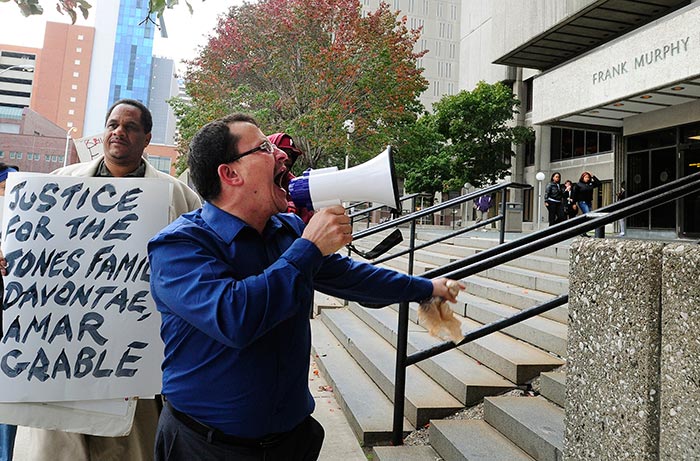Davontae Sanford's Road to Freedom
The appeals process
By George Hunter / The Detroit News
Attorney Heidi Naasko, left, attorney for Davontae Sanford, and Valerie Newman, attorney with the State Appellate Defender Office, hold a press conference at Dykema Gossett Law Firm at the Renaissance Center in Detroit, June 7, 2016, to discuss the vacating of murder convictions for Davontae Sanford. Photo: David Guralnick / The Detroit News
While Sanford’s attorneys worked to exonorate Sanford, prosecutors pointed to his confession and guilty plea as evidence of his guilt. But according to the Innocence Project, 30 percent of prisoners who were exonerated by DNA evidence had provided police a false confession.
Within months of Sanford’s conviction, the State Appellate Defender’s Office took up his appeal, arguing his confession and subsequent guilty plea were the result of police coercion, bad advice from a bad lawyer, and the immaturity of a 14-year-old learning disabled kid.
SADO attorney Kim McGinnis filed a motion to withdraw Sanford’s plea agreement in the fall of 2008; months after filing the motion, she said she found out Vincent Smothers had confessed to the killings on Runyon, not from prosecutors or police, but from a journalist.
McGinnis amended her motion to include the newly-discovered evidence: Smothers’ confession. Judge Brian Sullivan, who had presided over Sanford’s two-day trial, denied the motion without holding a hearing, but the Michigan Court of Appeals overturned the judge, and remanded the case back to the lower court for an evidentiary hearing on Sanford’s innocence.
Sanford’s attorneys had hoped Smothers would take the witness stand and tell the court he, not Sanford, was responsible for the killings, but the hit man invoked his Fifth Amendment rights and said nothing. Smothers later said he declined to confess because he was afraid he’d be labeled a snitch in prison, and didn’t want to face life in prison, although he later changed his mind and said he’d testify.
Although Smothers at first declined to take the witness stand, he waived his attorney-client privilege to allow his lawyer, Gabi Silver, to testify on his behalf that Sanford was not involved in the killings, but Sullivan would not allow her testimony.
When Smothers later agreed to testify, the judge wouldn’t let him take the stand, because he said earlier Smothers had invoked the Fifth Amendment.
In 2012, Smothers submitted an affidavit that said Sanford was innocent, but Sullivan denied the motion to withdraw the guilty plea.

"Kim Worth, not worthy" calls out Roberto Guzman as he and 17 others protest in front of the Frank Murphy Hall of Justice concerning police wrong doings in several cases including the Aiyana Jones, Davontae Sanford and Lamar Grable cases in 2013. Photo: Daniel Mears / The Detroit News
The state appellate court in September 2013 vacated Sullivan’s ruling and remanded the case back to his court for a hearing in which Smothers or his attorney would be allowed to testify.
Prosecutors appealed the appellate court decision, and on April 25, 2014, the Michigan Supreme Court vacated the ruling. The state high court said the entire argument was procedurally flawed. In their ruling, however, the state Supreme Court noted its order was “without prejudice to the defendant’s ability to file a motion for relief from judgment pursuant to MCR 6.500 et seq. raising the issues addressed in his motion to withdraw plea.”
In April 2015, the University of Michigan Innocence Clinic and the Northwestern University School of Law Center on Wrongful Convictions of Youth filed the latest effort to free Sanford, a motion for relief of judgment.
Their latest argument, which ultimately proved successful, was that they’ve uncovered new evidence and information that was not available in 2007 or 2008 which further implicates Smothers and clears Sanford in the Runyon killings.
Detroit News: Judge vacates conviction of teen in quadruple homicide